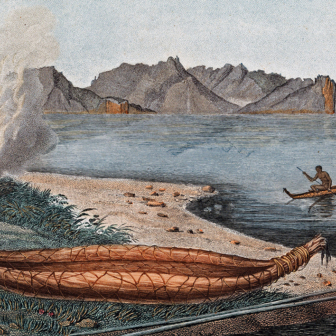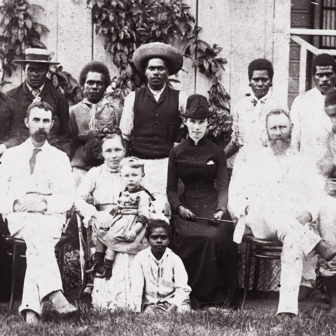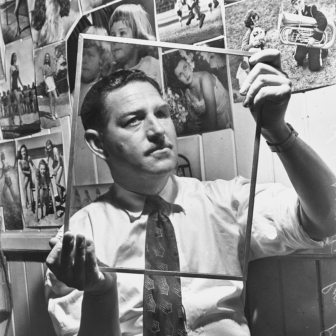Running through Anne Maxwell and Lucy Van’s new book, Australian Women’s Historical Photography, is the word “freedom,” sometimes used by the authors and sometimes by the photographers themselves. For these women, active at some point between the late nineteenth century and the end of the second world war, photography offered the freedom to assert the self over an otherwise restrictive world. They could compose their own views of that world rather than simply accept someone else’s.
Maxwell and Van focus on the lives and works of around half a dozen pioneers of the new medium, revealing both the individuality of each woman’s photographic practice and the characteristics they had in common. The stories of how they came to take up photography, of how their interest grew over time and then for one reason or another faded away, repeatedly echo and complement one another, establishing an implied kinship that supports fruitful comparisons.
Maxwell and Van make early note of the distinction increasingly drawn during this period between amateur and professional photography, going on to show how these distinctions sometimes overlapped and how the technically imperfect image may give today’s viewer a greater sense of immediacy and connection with the past than the more polished, professional one.
The camera presented women with opportunities for creative expression that frequently operated, as it were, undercover. In the guise of observer and documenter of family and domestic life, with their artistic ambitions undeclared except perhaps to themselves and sometimes not even then, they were able to act with autonomy, even if it meant, as no doubt it sometimes did, masquerading as a mere presser of the shutter.
These opportunities didn’t come with the medium’s very beginnings. It was only in the later years of the nineteenth century and the early twentieth, when cumbersome and expensive equipment was no longer required, that women were able embrace photography in any numbers or, perhaps more significantly, were given social permission to do so.
The first camera was typically a gift, and often a gift from a man — a father, a brother, a husband — quite possibly presented with the thought that it would make for a diverting hobby, something to occupy the days and fill the family album. Of the photographers Maxwell and Van discuss in detail, one, Sarah Chinnery, had her interest sparked when a brother “gave her a Little Nipper camera.” Another, Hedda Morrison, “was given a Box Brownie as a child.”
“Give a woman a Kodak and she will be able to make delightful pictures of all her home life, her family and her friends,” says a 1916 advertisement. But a gift intended very often as the means to practise an undemanding hobby had the potential to become something more. As Maxwell and Van tentatively observe of the amateur photographer Ada Armytage, who took up the medium in the early 1880s, “the relative freedom afforded by the pursuit of photography may have compensated for some of the conventional limitations placed on young women in the late Victorian era.”
Occasionally and more rarely, photography offered another kind of freedom, that of an independent profession. Maxwell and Van focus on two examples, the German-born Hedda Morrison, who was unusual in studying photography formally and in pursuing a successful and life-long career in photography, and the Moore sisters, Mina and May, who achieved considerable success as studio photographers in the years immediately before and after the first world war.
May Moore, who had trained in fine art, was intrigued by the possibilities of photography. Following on some minimal acquaintance with the new medium, she took the initiative and purchased with Mina a photographic studio in their native New Zealand. They quickly learned the basics and before long, in 1910, had transferred their business acumen and newly acquired skills to a studio in Sydney, with Mina opening a second studio in Melbourne two years later.
Working both together and separately, the sisters specialised in society and theatrical portraiture. With the coming of the war, they were well positioned to take advantage of the new demand for pre-embarkation photographs intended for distribution by the sitters to families and friends.
The images of these young men — captured either smiling or pensive, sometimes in the act of smoking or lighting a pipe — owe their distinctive air of deliberate construction not only to props (the pipes among them) but also to the sisters’ sophisticated understanding of studio lighting techniques, which the authors analyse in some depth. The men’s faces are typically shown as half in light, half in shadow, an effect that makes them seem “to emerge from the dark to lean into the light.”
In May Moore’s “Gunner Leopold Eric Alexis Ferguson (1915),” the lighting effects are complemented by the obvious care the photographer has taken to ensure that the soldier’s uniform — specifically his upturned lapel and the peak of his cap — match and echo his profile, giving an almost over-composed effect that characterises the work of both sisters.

May Moore, Studio portrait of Leopold Eric Alexis Ferguson, c. December 1915. Australian War Memorial
Sometimes, as in this image, the almost mathematical care taken with composition does nothing to dampen the humanity of the sitter. In other examples, such as May Moore’s portrait of 2nd Lieutenant Warwick Fussell in the act of lighting his pipe, the concern with composition can have the opposite effect, sacrificing humanity to staginess. We can almost hear the photographers’ instructions to the sitter to hold his head just so. We can equally imagine the number of times he was asked to light a match.
It is possible to appreciate the sophisticated professionalism of May and Mina Moore’s studio portraits while also allowing that this quality of deliberateness, so characteristic of their work, often serves to establish a certain barrier between image and viewer. The surviving examples of their wartime photographs have a sameness about them, governed by their deference to these conventions and rescued from that sameness only by the uniqueness of the individual sitters.
A contrasting figure who also made pre-embarkation photographs, in this case as an amateur with no overt claims to professional expertise, is Doris McKellar. McKellar was born into a wealthy family in Melbourne in 1897. She went on to study at the University of Melbourne, graduating in 1920 and soon becoming one of the very few women to be admitted as a barrister and solicitor. By 1925 she was married and had given up the law. Maxwell and Van quote her brief remark on this change of direction — “Marriage claimed me” — capable in its simplicity of an infinity of interpretation.
While she was still a student, McKellar began, like May and Mina Moore but with an amateur rather than a professional eye, to take photographs of newly enlisted military recruits, finding subjects among her relatives and friends. They were largely her contemporaries, and something of the shared generational experience between photographer and subject shines through, infusing her images with a tongue-in-cheek liveliness even as the young men she is photographing have clearly been instructed to pose.
As Maxwell and Van put it, McKellar “gives the social self priority over the soldierly self” something that emerges clearly from the photograph she took of her brother Hugh, which the authors single out for particular attention. Unlike studio portraits of the time, which tend to have a maturing effect on their military subjects, McKellar’s photograph of Hugh Hall shows him to be what he is, a boy dressed up as a soldier, posing as such with a winning combination of seriousness and sly humour. The shadow cast by his slouch hat is sharper and less mannered than the shadows on the faces of May and Mina’s soldiers, there are creases in his collar and shirt pockets, and the further shadow cast by his legs and torso juts out at an unaesthetic angle.

Doris McKellar, “Glenmoore, H.P.H.” Standing full-length snapshot portrait of Hugh Percival Hall, c. 1915–19. Doris McKellar Collection, University of Melbourne
McKellar left little direct commentary about her own work. The picture of her brother in uniform is one of the few of her images to benefit from a caption. In other words, there is not much to go on, other than the photographs themselves. In the absence of additional documentary evidence — an absence that is the norm when it comes to snapshots and found photographs — Maxwell and Van are more than justified in a little tentative speculation. The extent to which the image of Hugh Hall is clearly posed in the manner of formal studio portraiture seems, the authors suggest, “to derive from some of those codes.” Moreover, it is the imperfect application of these codes, leading to a gap between convention and spontaneity, that imbues the image with its vitality, further suggesting that technique is by no means everything.
Maxwell and Van say of another of these amateur photographers, Sarah Chinnery, whose work they discuss in some detail, that she was able to take advantage of “the freedom that came from being both a housewife and an amateur photographer.” This remark posits a rather more nuanced way of considering the work of non-professional women photographers than via a simple opposition of marriage (stifling) and photography (liberating).
Chinnery was married to a government appointed anthropologist, in the course of whose work the couple spent decades in New Guinea and the islands, leaving only with the approach of the second world war. Ernest Chinnery took many photographs of a documentary nature as part of his official duties, often including them in his reports. Sarah Chinnery, unconstrained by official requirements, was able to make images of similar subjects with a notably more personal and sympathetic eye.
Sarah, who had continued since childhood to pursue her interest in photography, was suddenly presented with another kind of gift — a new and unfamiliar world, crammed with potential subjects, to which she could respond with her camera. Her most effective images thus convey, to an unusual extent given the time and place, qualities of naturalness and individuality that go well beyond anthropological documentation.
Unlike Doris McKellar, Chinnery provided her photographs with captions. She also kept a diary in which she jotted down background remarks. Her image, “Two Young Girls With Limed Hair, Rabaul, 1933,” which Maxwell and Van identify as being “especially striking,” captures the conjunction of tradition and modernity in a way that depicts, perhaps naively so, this conjunction as unforced and unproblematic.

Sarah Chinnery, Two young girls with limed hair, Rabaul, 1933. National Library of Australia
“A couple of pretty young girls came along the road,” Sarah Chinnery notes in her diary. “One wore a dog’s-tooth necklace, and long drooping rings of black tambu shell in her ears [while] the other girl wore a green blouse.”
For Chinnery, as for most of the women photographers considered here, the periods in which they were most active and in which they produced their most successful images were relatively brief. Events moved on, other obligations took precedence, or the available subject matter failed to engender a sufficient spark. Maxwell and Van remark of Sarah Chinnery that “none of her many photographs over the next twenty-six years captured the interest of her New Guinea photographs.”
The qualities of human interest and affectionate response that characterise Chinnery’s New Guinea photographs are also apparent in the work of Indigenous photographer Mavis Phillips, whose recently resurfaced archive of images formed the basis of an exhibition at the Perth Centre for Photography in 2021. We don’t know how Phillips acquired her first camera, although we do know, or can guess almost before we read it here, that it was a Box Brownie.
Phillips’s photographs, made over an extended span beginning in 1930s, exude “happiness, freedom, health, vitality and connectedness.” What is implied in the discussion of Sarah Chinnery is here made explicit — that Phillips, unconstrained by any bureaucratic obligations to record, was free to produce work that addresses a modern-day viewer more directly and more convincingly than “most other photographs of Aboriginal people made in this period by mission and government workers, or ethnographers and anthropologists.”
Of all the photographic illustrations included in Australian Women’s Historical Photography,” two by Phillips leave a lasting impression. “Young Boy on Top of Large Haystack in Goomalling” and “Young Woman Sitting on a Large Boulder in Goomalling,” in their similarity of subject and composition, suggest a deliberateness of intent that combines effectively with the characteristic spontaneity of the snapshot.

Mavis Phillips (née Whalley). Above: Young boy on top of a large haystack in Goomalling, c. 1900–50. Below: Young woman sitting on a large boulder at Goomalling, c. 1900–50. Mavis Phillips (née Whalley) Collection, State Library of Western Australia, with the permission of the photographer’s family and the SLWA.

The two images complement and enhance each other. Both are shot from a low angle, wittily emphasising the mass of the haystack and the boulder, and in both photographs a clear and open sky takes up the entire top third of the frame. Phillips renders her subjects as both dwarfed and cheekily dominant, conveying something particularly Australian about the relaxed yet precarious relationship of these young people with the natural world, as they perch determinedly above its imposing mass.
The professional photographers Maxwell and Van discuss in detail — the Moore sisters and Hedda Morrison — have had by far the most critical attention up till now. The names of the amateurs — Doris McKellar, Sarah Chinnery, Ada Armytage and Mavis Phillips — will be much less familiar to most readers. One of the achievements of Australian Women’s Historical Photographs is to show how the work of these relatively unsung photographers can, despite but also because of their amateur status, so effectively draw us into the past. •
Australian Women’s Historical Photography: Other Times, Other Views
By Anne Maxwell and Lucy Van | Anthem Press | $49.99 | pages




